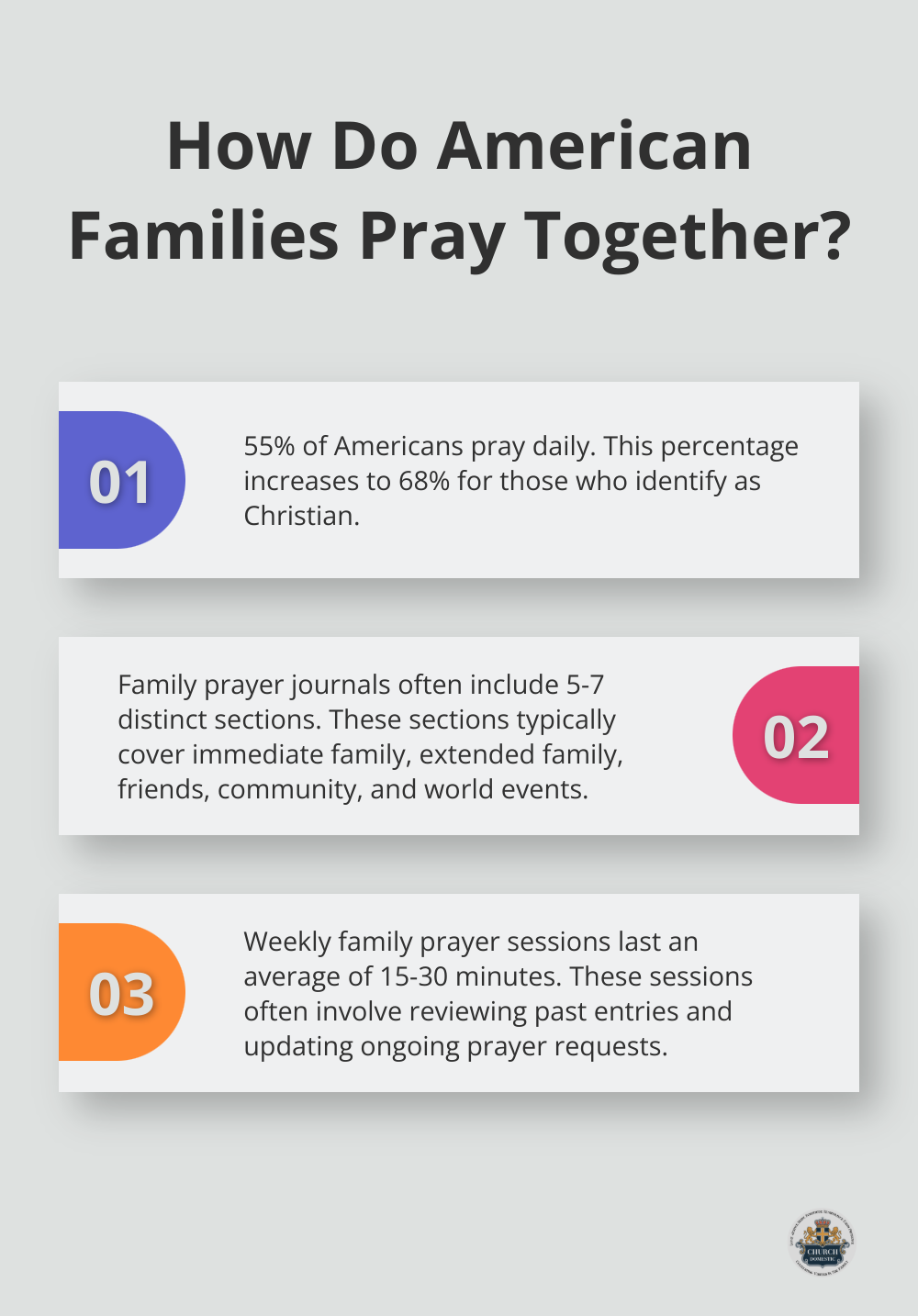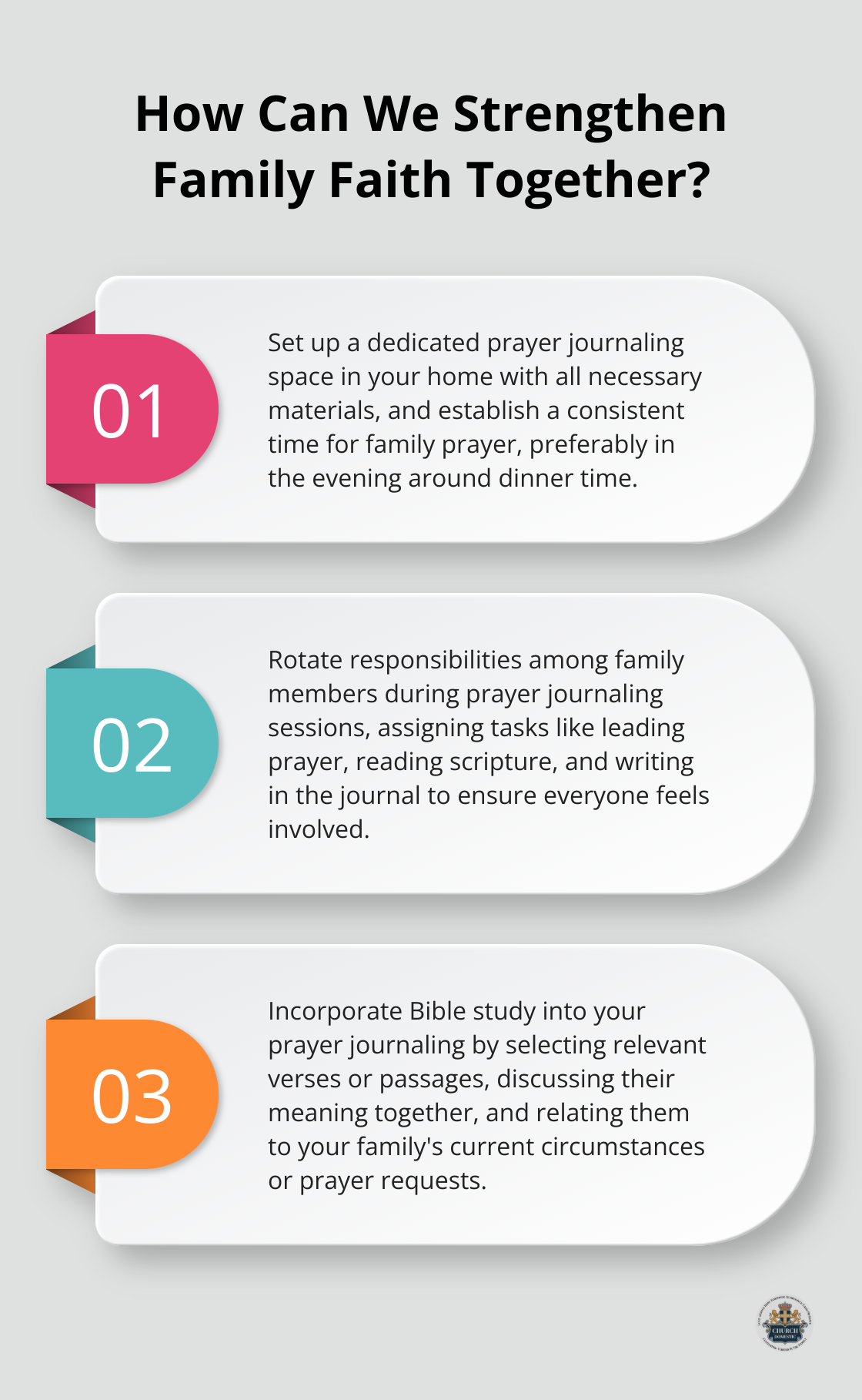At Church Domestic, we believe in the power of prayer to strengthen family bonds and deepen faith. Prayer journaling offers a unique way for families to connect with God and each other.
This practice can transform your family’s spiritual life, creating a lasting record of your journey together. In this post, we’ll guide you through starting and maintaining a family prayer journal, helping you build a meaningful tradition that will enrich your home for years to come.
Selecting Your Family’s Prayer Journal
Size and Durability: Key Considerations
The selection of your family’s prayer journal marks the beginning of a meaningful spiritual practice. A larger format (A4 or letter-sized) provides ample space for multiple family members to express themselves. We recommend journals with at least 200 pages to accommodate a year’s worth of entries.
Durability should not be overlooked. A hardcover journal with high-quality paper can withstand daily use and occasional spills. Journals with reinforced bindings (such as those from Moleskine or Leuchtturm1917) prove excellent choices for withstanding the rigors of family life.
Digital vs. Physical: Weighing the Options
While traditional paper journals charm many, digital options offer unique benefits for modern families. Apps like Day One or Journey allow multiple users to contribute to a shared journal, facilitating easy entries from various devices.

However, research supports the benefits of handwriting. Studies have shown that individuals who regularly write by hand have better neural connections and stronger overall cognitive abilities. This suggests that a physical journal might enhance spiritual growth and reflection more effectively.
Reflecting Your Family’s Unique Style
Your prayer journal should mirror your family’s distinctive style and values. We suggest involving everyone in the selection process. You might choose a journal with a cover design that resonates with your family’s aesthetic or one that allows for customization.
Some families prefer journals with pre-printed prompts or Bible verses, while others favor blank pages for maximum flexibility. The Gratitude Journal by Promptly Journals, for example, offers a mix of structured and free-form pages that can suit various family preferences.
Practical Tips for Journal Selection
- Consider the age range of your family members when choosing the journal format.
- Test different pens on the paper to ensure smooth writing (this can significantly impact the journaling experience).
- Look for journals with built-in bookmarks or elastic closures for easy navigation and protection.
The most effective journal is one that your family will consistently use. Whether it’s a simple composition notebook or a leather-bound tome, the most critical factor is that it feels right for your family and encourages regular use.
Now that you’ve selected the perfect journal for your family, let’s explore how to set it up for maximum engagement and spiritual growth.
How to Organize Your Family Prayer Journal
Designate Specific Prayer Categories
Start by dividing your journal into distinct sections. The Navigators suggest five steps to organizing a prayer journal, including setting a pattern, recording praise and intercession, including personal worship, storing treasures, and incorporating “stones of remembrance.” This organization focuses prayers and ensures a balanced approach to your family’s spiritual life.

Dedicate the first few pages to immediate family needs, followed by sections for extended family, friends, and your local community. Include a section for world events and missions to broaden your family’s perspective. Lastly, create a space for individual family members to express their personal prayers and reflections.
Create a Gratitude and Answered Prayers Section
Allocate a significant portion of your journal to record gratitude and answered prayers. This practice reinforces positivity and builds faith. A study found that gratitude list interventions showed significant improvement in perceived stress and depression.
Encourage each family member to write down at least one thing they’re thankful for daily. For answered prayers, consider using a color-coding system. For instance, use green to highlight prayers that have been answered, yellow for those in progress, and red for ongoing requests.
Implement a Regular Update System
Consistency is key in maintaining an effective family prayer journal. Establish a routine for updates that fits your family’s schedule. Many families find success with a weekly update session (often on Sunday evenings).
During these sessions, review the past week’s entries, update ongoing prayer requests, and plan for the week ahead. This regular practice not only keeps your journal current but also serves as a family bonding activity.
To make updates more engaging, try rotating responsibilities. Assign different family members to lead the update sessions each week. This approach fosters ownership and ensures everyone’s voice is heard in the prayer journaling process.
Customize Your Journal Layout
Your family prayer journal should reflect your unique needs and preferences. Try different layouts and formats until you find one that works best for your family. Some families prefer a structured approach with pre-defined sections, while others opt for a more freeform style.
Consider adding creative elements to your journal. Use stickers, colored pens, or even small drawings to make the journaling process more engaging (especially for younger family members). These visual elements can help bring your prayers to life and make the journal a treasured family keepsake.
As you set up your family prayer journal, keep in mind that this is just the beginning of your journey. The next step is to seamlessly incorporate this practice into your daily family life, which we’ll explore in the following section.
Making Prayer Journaling a Family Habit
Create a Sacred Space and Time
Designate a specific area in your home for prayer journaling. This could be a cozy corner of the living room or a quiet spot in the kitchen. Place your family prayer journal, pens, and other necessary materials in this area. A dedicated space signals to everyone that it’s time to focus on prayer.

Choose a time that works best for your family’s schedule. Many families find success with evening prayer journaling, just before or after dinner. Research suggests that the time kids spend in prayer is a significant predictor of positive adult spiritual outcomes. Set a consistent time to increase the likelihood of sticking with the habit.
Involve Everyone in the Process
Make prayer journaling interactive and engaging for all family members. For younger children, use stickers or drawings to represent their prayers. Teenagers might prefer to type their entries on a shared digital document. The key is to accommodate different preferences while maintaining the communal aspect of the practice.
Rotate responsibilities among family members. One person can lead the prayer time, another can read from the Bible, and someone else can write in the journal. This approach ensures everyone feels invested in the process.
Turn Prayer Journaling into a Learning Experience
Use your family prayer journal as a tool for spiritual education. When you pray for world events, take a moment to discuss the context and how your faith informs your response. This not only broadens your children’s worldview but also helps them understand the practical application of faith.
Incorporate Bible study into your prayer journaling sessions. Choose a verse or passage that relates to your family’s current circumstances or prayer requests. Discuss its meaning together and how it applies to your lives. This practice helps deepen everyone’s understanding of scripture and its relevance to daily life.
Adapt and Grow
Be flexible in your approach to family prayer journaling. As your family grows and changes, so too should your practice. Try different methods and techniques (such as themed prayer weeks or incorporating music) to keep the experience fresh and engaging.
Encourage open communication about the prayer journaling process. Ask for feedback from family members and be willing to make adjustments. This adaptability will help ensure that prayer journaling remains a meaningful and cherished part of your family’s spiritual journey.
Final Thoughts
Prayer journaling strengthens spiritual bonds and creates lasting memories for families. It fosters open communication, teaches reflection, and provides a tangible record of growth and answered prayers. Families who engage in this practice often experience improved relationships, increased gratitude, and a deeper understanding of each other’s needs and aspirations.

We at Church Domestic encourage you to start your family prayer journal today. This simple practice can transform your family’s spiritual life and create a legacy of faith for future generations. You don’t need to wait for the perfect moment – begin now and embrace the process with patience.
For more resources on family life and faith, visit us at Church Domestic. Let’s grow together in faith, one prayer at a time (and watch as your family’s spiritual journey unfolds through the pages of your journal).